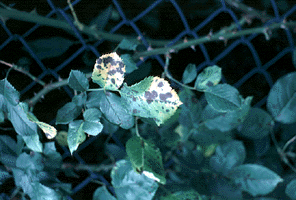 |
|
Return to Roses - Descriptions and Photos page Return to Glossary page |
 |
|
Return to Roses - Descriptions and Photos page Return to Glossary page |
Well,
first, roses get blackspot and humans get colds, but the question why is
the thing. The two chief factors which determine whether a rose is susceptible
to blackspot are growing conditions and lineage. We'll discuss these factors,  completing
the discussion with suggestions on how to deal with this aggravation. completing
the discussion with suggestions on how to deal with this aggravation.
What is blackspot? Diplocarpon rosae, common name, blackspot, is a fungus which is the most widely distributed and most destructive disease in rose culture. Symptoms start with black or gray spots, followed by chlorosis, or yellowing of the remainder of the leaf. Defoliation follows, and in severe cases, the rose may actually perish. Blackspot thrives in damp, humid, warm weather, and by the way, by the time you see the black spots on the leaves, the fungus is well established on the plant. Sounds dire, doesn't it? Well, the good news is that blackspot is usually a visual nuisance (who wants bare, leafless, rose canes in their garden?), and if proper care is taken, blackspot need be nothing more than a minor headache from time to time. In order to not add too many chemicals to the environment, I limit the amount of spraying I do; I can attest that through selection of resistant varieties and the occasional spray placed on my more delicate roses that blackspot is not a real problem in my own rose gardens. We should strive to move towards a philosophy in the garden that to grow roses successfully does not mean a resignation to constant spraying and fuss. Chemical
Control is Good, but Balance In All Things Is Important.
|